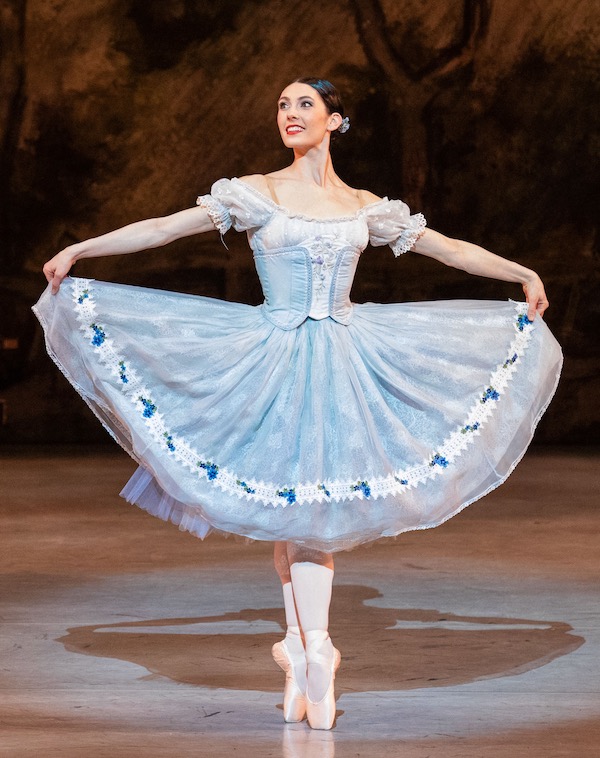Ballet West’s refreshed “Giselle” creates a moving tale of perseverance

Some people may consider a ballet made 179 years ago inherently passé. But Friday night’s season premiere of Giselle by Ballet West at the Capitol Theatre offered a vibrant and vital performance. Rather than the traditional story focused on the fragility of the title character and her manipulation by a dishonest Duke, the cast turned the tale into a timeless narrative of desire, conviction, and perseverance.
Choreographed in 1841 by Jean Coralli and Jules Perrot, Giselle features music by Adolphe Adam. For Ballet West’s performances, Adam Sklute, the company’s artistic director, reworked the production with principal ballet master Pamela Robinson Harris. Music director Jared Oaks collaborated with Sklute and Harris to create a version of Adolphe Adam’s music that’s both succinct and scintillating. The dancers perform as if compelled by the passions of the plot, and Oaks’ conducting intensifies the emotions of each scene.
What became refreshingly apparent on Friday night is the range of characters the women of Ballet West can portray. In the role of Giselle, Beckanne Sisk was charming and forthright, insistent on dancing in spite of her mother’s admonishment. Bathilde, the fiancée of Albrecht, the Duke of Silesia, is as integrous and grounded as the Duke is slippery and untruthful. Although the role does not require much dancing, Bathilde was performed by Katlyn Addison, and her presence and elegance instantly signaled a royal lineage.

Throughout the second act, the stage is full of fierce women. As the Queen of the Wilis, Myrthe is one of the most domineering female roles in the ballet canon. Allison DeBona was a powerful presence as Myrthe, while Emily Neale and Gabrielle Salvatto were captivating as her henchwomen, Moyne and Zulmé.
The cast of 18 Wilis were equally strong. They showcased the distinct knowledge and intelligence that’s required of corps de ballet dancers as they create images of synchronicity and symmetry. When they chugged across the stage, passing one another with their legs extended in arabesques, the choreography suggested a trapping device these women use to ensnare men.
As this production showcased a spectrum of female characters, it also reinforced their power over men. It is Giselle’s generosity that saves
Albrecht’s life, and the final scenes between Sisk as Giselle and Chase O’Connell as Albrecht were poignant. His hubris caused her demise, yet she helps him survive the relentless Myrthe and Wilis. It takes incredible strength to forgive such betrayal, and she manages to make the moment credible and deeply moving.
In contrast to the gloom of Act 2, the ballet begins in lively and cheerful style. Through Skulte and Harris’s retooled choreography, there is ebullient dancing by the company and Ballet West II, and a terrific balance between scenes with Giselle, Albrecht, and Hilarion that advance the plot.
Particularly impressive on Friday night was the Peasant Pas de Quatre performed by Jenna Rae Herrera, Chelsea Keefer, Alexander MacFarlan and Jordan Veit. MacFarlan and Veit bounded through their series of jumps while Herrera and Keefer executed perfect turns. Their performance was a brilliant diversion from the story, and provided an excellent contrast between the honesty and joy of these four dancers and the duplicity of Albrecht.
A theme that is emphasized in this version is that people are not always who they appear to be: although Hilarion, played wonderfully by Hadriel Diniz, professes to love Giselle, his jealously of Albrecht leads to her downfall. Albrecht is similarly impetuous: he lunges at Hilarion with his sword in Act 1, and ultimately both men reveal how impulsive behavior causes destruction and ruin.
Alongside this indictment, there’s another interesting twist in this production: the wealthy tend to get away with their misdeeds. At the end of Act 1, when Giselle is dead, Albrecht’s squire, performed excellently by Tyler Gum, wraps a cloak around him and whisks Albrecht away from the scene of destruction. It’s a telling commentary on who can escape inexcusable situations, and who cannot.
Of course it’s also possible to interpret Giselle as the story of a frail woman whose life is destroyed by a domineering man. Indeed, Théophile Gautier, the critic who wrote Giselle’s libretto, was in love with Carlotta Grisi, the dancer who performed Giselle in 1841, and she was romantically involved the choreographer Perrot.
Yet Ballet West’s refitted version works as a call for self-awareness, and a story that reveals the interdependence of all people. One left the theater thinking about a quote by Mark Twain, “What would men be without women? Scarce… mighty scarce.”
Ballet West’s Giselle continues through February 15. balletwest.org